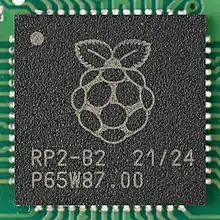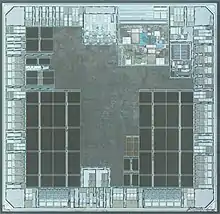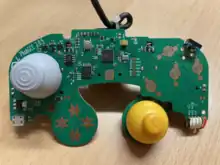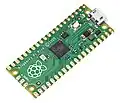RP2040
RP2040 is a 32-bit dual ARM Cortex-M0+ microcontroller integrated circuit[1][2][3] by Raspberry Pi Ltd. In January 2021, it was released as part of the Raspberry Pi Pico board.[1]



Overview
Announced on 21st January 2021, the RP2040 is the first microcontroller designed by Raspberry Pi Ltd.[1][2] The microcontroller is low cost, with the Raspberry Pi Pico being introduced at US$4 and the RP2040 itself costing US$1. The microcontroller can be programmed in assembly, C, C++, Free Pascal, Rust,[4] Go, MicroPython, CircuitPython,[1][5] and Ada.[6] It is powerful enough to run TensorFlow Lite.[1]
At announcement time, four other manufacturers (Adafruit, Pimoroni, Arduino, SparkFun) were at advanced stages of their product design, awaiting the widespread availability of chips to be put in to production.[7]
Hackaday notes the benefits of the RP2040 as being from Raspberry Pi, having a good feature set, and being released in low-cost packages.[8]
Per the datasheet, there are multiple revisions of the chip:
"The full source for the RP2040 bootROM can be found at https://github.com/raspberrypi/pico-bootrom. This includes both version 1 and version 2 of the bootROM, which correspond to the B0 and B1 silicon revisions, respectively."
Features
The chip is 40 nm silicon in a 7 × 7 mm QFN-56 surface-mount device (SMD) package manufactured by TSMC.[9]
- Key features:[10]
- 133 MHz dual ARM Cortex-M0+ cores (supports overclocking[3])
- Each core has an integer divider peripheral, and two interpolators.
- 264 KB SRAM in six independent banks (four 64 KB, two 4 KB)
- No internal flash or EEPROM memory (after reset, the boot-loader loads firmware from either external flash memory or USB into internal SRAM)
- QSPI bus controller, supporting up to 16 MB of external flash memory
- DMA controller
- AHB crossbar, fully-connected
- On-chip programmable low-dropout regulator (LDO) to generate core voltage
- 2 on-chip PLLs to generate USB and core clocks
- 30 GPIO pins, of which 4 can optionally be used as analog inputs
- 133 MHz dual ARM Cortex-M0+ cores (supports overclocking[3])
- Peripherals:
Boards
A number of manufacturers have announced their own boards using the RP2040. A selection of the growing number is here:
| Board name | Manufacturer | Size (mm) | Header pins | Debug connection | Number of pads | USB connector | Other connectors | Flash size | GPIO pins | ADC pins | Buttons | Other features | Image |
|---|---|---|---|---|---|---|---|---|---|---|---|---|---|
| Pico[11] | Raspberry Pi Ltd | 51×21 | 40+3 | via headers | 6 | micro-USB | 2 MB | 26 | 3 | BOOTSEL |  | ||
| Pico W[12] | Raspberry Pi Ltd | 51×21 | 40+3 | via headers | 6 | micro-USB | 2 MB | 26 | 3 | BOOTSEL | Wi-Fi, Bluetooth | .jpg.webp) | |
| XIAO RP2040[13] | Seeed Studio | 20×17.5×3.5 | 14 | Reset Button/ Boot Button | USB Type-C interface | 2 MB | BOOTSEL + RESET | ||||||
| Nano RP2040 Connect[14] | Arduino | 45×18 | 30 | via pads | 5+4+2 | micro-USB | 16 MB | 1 | Wi-Fi, Bluetooth, 9-axis IMU, microphone | .jpg.webp) | |||
| Tiny 2040[15] | Pimoroni | 22.9×18.2×6 | 8+3 | via headers | USB-C | 8 MB | 12 | 4 | BOOTSEL + RESET | ||||
| Keybow 2040[16] | Pimoroni | 0 (USB only) | USB-C | 2 MB | 16 keys | ||||||||
| PicoSystem[17] | Pimoroni | 96.6×42.7×15.5 | 0 (self contained) | USB-C | 16 MB | 4 + joypad | Color 240×240 LCD, onboard battery | ||||||
| Feather RP2040[18] | Adafruit | 51×23×7 | 28 | via pins | USB-C | STEMMA QT, lipo battery | 8 MB | 21 | 4 | BOOTSEL + RESET | Battery charger | ||
| ItsyBitsy RP2040[19] | Adafruit | 36×18×4 | 33 | via headers | micro-USB | 4 MB | 23 | 4 | BOOTSEL + RESET | ||||
| Metro RP2040[20] | Adafruit | 53 x 71 x 13 | 32 | SWD + 3 pin JST SH compatible | USB Type-C | DC jack for 6-12VDC / STEMMA QT / SWD / pico probe | 16 MB | 24 | 4 | BOOTSEL + RESET | NeoPixel LED, Micro SD | ||
| QT Py RP2040[21] | Adafruit | 22x18x6 | 14 | Reset Button/ Boot Button | USB-C | STEMMA QT | 8 MB | 13 | 4 | BOOTSEL + RESET | 3.3vdc regulator, NeoPixel LED | ||
| Pro Micro – RP2040[22] | Sparkfun | 36×18 | 24 | 4+2 | USB-C | QWIIC | 16 MB | 20 | 4 | BOOTSEL + RESET | .jpg.webp) | ||
| Thing Plus RP2040[23] | Sparkfun | 59×23 | 28 | JTAG pins | USB-C | QWIIC, lipo battery | 16 MB | 18 | 4 | BOOTSEL + RESET | Battery charger | .jpg.webp) | |
| MicroMod RP2040[24] | Sparkfun | 22×22 | 0 | edge connector | edge connector | 16 MB | 29 | 3 | none | .jpg.webp) | |||
| Müsli USB Pmod[25] | Lone Dynamics | 45×20.32 | 12 | SWD | USB Type-A female | 12-pin male PMOD, SWD | 256 KB | 8 | 0 | BOOTSEL | USB host, 5V boost converter | ||
| Werkzeug USB Multi-Tool[26] | Lone Dynamics | 50×50 | 32 | USB-C | 12-pin female PMOD, USB Type-A female | 1 MB | 24 | 4 | BOOTSEL | USB device/host, PMOD | |||
| RP2040[27] | WeAct Studio | 53x21.52 | 40+4 | via headers | USB-C | 2MB, 4MB, 8MB, 16MB | 26 | 4 | BOOTSEL + RESET | ||||
| RP2040-Zero[28] | Waveshare Electronics | 23x18 | 23 | USB-C | 10-pad connector | 2MB | 29 | 4 | BOOTSEL + RESET | RGB LED
(WS2812) |
|||
| Pico2040 | zeankun.dev | 18x51 | 40+3 (2mm and 2.54mm variants are available) | SWD | 4 | micro-USB | 16MB,
32MB, 64MB, 128MB |
28 | 4 | BOOTSEL
+ RESET |
See also
- Arduino – a popular microcontroller board family
- ESP32 – a series of low-cost, low-power system on a chip microcontrollers with integrated Wi-Fi and dual-mode Bluetooth.
- STM32 – a family of 32-bit microcontroller integrated circuits
- Raspberry Pi – Raspberry Pi's series of small single board computers
- Thumby (Game Console) – a thumb-sized micro-console powered by the RP2040
References
- "Meet Raspberry Silicon: Raspberry Pi Pico now on sale at $4". January 21, 2021.
- Adams, James (1 February 2021). "Raspberry Pi RP2040: Our Microcontroller for the Masses". Arm Blueprint. Retrieved 20 February 2021.
- "RP2040 Datasheet" (PDF). Raspberry Pi Ltd. Retrieved 20 February 2021.
- "Rust on the RP series of microcontrollers". GitHub. Retrieved 29 March 2023.
- Rembor, Kattni. "Getting Started with Raspberry Pi Pico and CircuitPython". Adafruit Learning System. Adafruit. Retrieved 17 February 2023.
- "Ada on the Raspberry Pi Pico". Retrieved 10 July 2023.
- "Tweet". twitter.com. Retrieved 2021-02-18.
- Williams, Elliot (20 January 2021). "Raspberry Pi Enters Microcontroller Game With $4 Pico". Hackaday. Retrieved 20 February 2021.
- "Raspberry Pi: Here's how we built our own chip to power the Pico". ZDNET. Retrieved 2023-10-05.
- "RP2040 Datasheet" (PDF). raspberrypi.com. Retrieved 2021-03-28.
- "Buy a Raspberry Pi Pico".
- "Pico W - Raspberry Pi | Rasppishop - Raspberry Pi Boards und Zubehör". Pico W - Raspberry Pi | Rasppishop - Raspberry Pi Boards und Zubehör (in German). Retrieved 2023-09-04.
- "Seeed Studio XIAO RP2040 - Supports Arduino, MicroPython and CircuitPython". www.seeedstudio.com. 2023-08-06. Retrieved 2023-09-04.
- "Welcome Raspberry Pi to the world of microcontrollers". 20 January 2021.
- "Tiny 2040 – Pimoroni".
- "Keybow 2040 – Pimoroni".
- "PicoSystem – Pimoroni".
- "Adafruit Feather RP2040".
- "Adafruit ItsyBitsy RP2040".
- "Adafruit Metro RP2040".
- "Adafruit QT Py RP2040".
- "SparkFun Pro Micro - RP2040 - DEV-18288 - SparkFun Electronics".
- "SparkFun Thing Plus - RP2040 - DEV-17745 - SparkFun Electronics".
- "SparkFun MicroMod RP2040 Processor - DEV-17720 - SparkFun Electronics".
- "Müsli USB Pmod™ Compatible Module".
- "Werkzeug USB Multi-Tool".
- Studio, WeAct (2023-08-17), RP2040 / WeAct Studio 微行工作室 出品, retrieved 2023-09-04
- "RP2040-Zero, A Low-Cost, High-Performance Pico-Like MCU Board Based On Raspberry Pi Microcontroller RP2040". www.waveshare.com. Retrieved 2023-09-04.